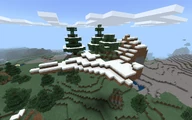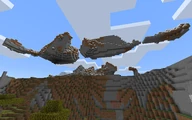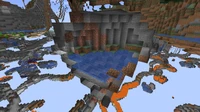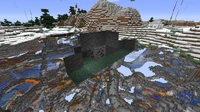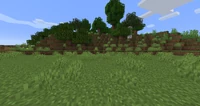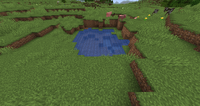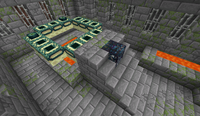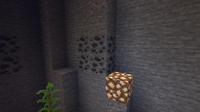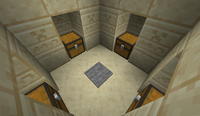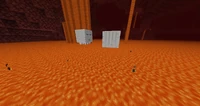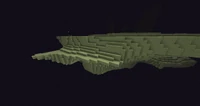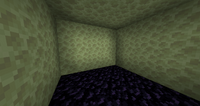(→Trivia) |
|||
| Line 940: | Line 940: | ||
{{main|End city#End ship}} |
{{main|End city#End ship}} |
||
| − | '''End ships''' have a fair chance of generating outside of end cities. They only place where [[elytra]] and a dragon head can be |
+ | '''End ships''' have a fair chance of generating outside of end cities. They only place where [[elytra]] and a dragon head can be obtained. |
<gallery widths="200px"> |
<gallery widths="200px"> |
||
Revision as of 01:54, 20 May 2018
Every specific group of blocks purposefully formed in Minecraft based on coding is part of a natural structure.
The Overworld
The Overworld contains numerous generated structures, at a wide variety of scales.
Terrain
Biomes dictate the shape and height of the world. At this stage, the ground is made mostly of stone and stone variants, with water filling in most empty spaces below layer 63, with exception for structures.
Mountain
Mountains are hills with extreme slopes and cliffs. Mountains can sometimes have caves through them. On an amplified world, mountains are extremely common in all biomes except ocean and swamp biomes.
Floating "island"
Floating "islands" are structures that float in midair that are not connected to the ground, the sea, hills or cliffs. Floating "islands" are normally just random pieces of floating dirt and stone found near cliffs, but on rare occasions they can be large, floating structures that even have springs and trees on them. Floating Islands are most frequently found in the extreme hills, ice plains, ice mountains and mushroom island biomes, but can be found anywhere. Floating Islands are very common in an amplified world.
Hollows
Hollows are the opposite of floating islands. They look like caves, but they have nothing to do with cave generation (although they may intersect with them). When there are many overhangs, they close together and create a hollow. They have exactly the same floor as the terrain above, depending on the biome that they are located in, unlike caves. Hollows have no specific floor. Grass can generate inside too, and interestingly will survive without light. When they generate under the sea level, they are filled with water. They are extremely rare in the default world, but can be found far more commonly in certain customized worlds.
A hollow in a customized world.
Hill
Hills are randomly generated pieces of land in the map. Like stairs, hills are always traversable to their lowest point by virtue of the algorithm which generates them; there is almost always a place on each level from where the next level can be accessed, meaning that the player can climb a hill one level at a time until they reach the top. Cases where this is not true are rare.
Beach
Beaches usually generate next to oceans and cover all nearby shorelines. They come in two different varieties: sand beach and stone beach. Sandstone is located below sand in sand beaches. Stone beaches are usually steep cliffs that lead straight into the water.
A mushroom biome next to a beach
- Oceanfront Mountains.png
A stone beach with steep cliffs
Surface
Surface layer
The uppermost layers of the terrain are converted to a biome-dependent material: usually grass blocks and dirt, or sand in deserts and beaches. Podzol is found in mega taiga, mycelium in mushroom island biomes, and red sand is found in the mesa biome. Gravel is generated under sand.
Basin
Occasionally, instead of being converted to dirt or sand, the top layer is stripped away, leaving a 'basin' of bare stone. They bear some resemblance to a geological 'shield' (an area of tectonically stable rock that has been exposed to prolonged erosion due to its very old age; it is distinct from the geological term "basin"). They seem to be more common in forest or plains, and are occasionally seen filled with water. Commonly, minerals can be found in these, generally coal ore and iron ore. If generated in a Mesa biome, gold ore can also be seen.
- Biomes Basin.png
A naturally generated basin landform
Water bodies
Ocean
Oceans/Seas are huge bodies of water with every single water tile being a source block. The ground can rise high enough to produce small, relatively barren islands.
- 1.13 Biomes Ocean.png
A picture of an ocean biome
- DeepOcean.png
A deep ocean, with an ocean monument in the background.
River
Rivers are long "strands" of water that cut through or separate biomes. They do not have a current. Patches of sand and gravel are seen commonly dotting the banks of the rivers, and clay settled at the very bottom. In some cases, rivers will generate higher than normal, producing a dry riverbed, sometimes with occasional small water patches.
Lake
Lakes are small bodies of liquid. Water lakes, which are small pools of water springs, can generate above sea level or inside caverns. They can also generate isolated underground, connected to no other structures whatsoever. When in a winter biome, these small lakes are never initially frozen but will turn to ice if exposed. The lakes can also be composed of lava; however, lakes of lava are much rarer. Lava lakes found at the surface are surrounded by stone (which can be replaced by ore veins such as dirt, gravel and coal). Both types of lake generate with a small air pocket above them, which may result in floating sand, floating snow cover or even the top 2/3rds of trees above the lake. Lava lakes may cause trees to burn away.
A lake in a plains biome.
- Mesa Lava Lake.png
A lava lake in a mesa biome
Large structures
Cavern
Caverns are caves and tunnels that are automatically generated under the ground in various places, composed of primarily stone and ores. In 1.13[upcoming], caves are able to generate in ocean biomes.
A dark cave with a zombie
Ravine
Ravines are tall, long cracks of air, usually measuring around 30 to 50 blocks in height, 84 to 112 blocks long and no more than 7 blocks wide. Ravines can have small ledges along the top. They can be found at levels 20 to 68, sometimes appearing on the world surface or underwater, forming canyons and trenches. They can go very deep underground, sometimes spawning slimes or exposing diamond ore. If they reach deep enough, they may also be floored by the lava lakes at level 11. In the Amplified world type, ravines can reach from surface level to bedrock. A ravine can be cut in half by water, separating the ravine into two parts that is abrupty stop with a wall of stone near the water. Ravines can also be found in oceans or rivers having a waterfall from the river/ocean falling into them. In 1.13, ravines can spawn in the ocean making it look like underwater trenches.[upcoming: Lua error in Module:Version_link at line 112: attempt to concatenate local 'text' (a nil value).]
Ravines can connect to caves, dungeons, abandoned mineshafts, and any other generated structures. Due to the large surface area of their walls, ravines often have water and/or lava flowing down them (from springs in the walls, underground lakes, or even openings to the sea).
In Bedrock Edition, ravines almost always go all the way down to bedrock, which causes lava to generate at the bottom. Obsidian often forms at the bottom as water sources flow down into the lava.
Two ravines open to the sky that generated next to each other, with a River biome between them.
An underwater ravine in 1.13.
Abandoned mineshaft
Abandoned mineshafts are structures generated underground (partially above ground in mesa biomes) which consist of branching mining tunnels with wooden supports and broken rails passing through it. They are the only places where cave spider spawners and minecarts with chests can be found naturally.
- AbandonedMineshaftRoom.png
A large cubic dirt room found in a mineshaft.
Stronghold
Strongholds are underground structures made up of stone bricks, monster eggs, and iron bars. They consist of many rooms, most notably libraries and end portal rooms. Although they are very rare, they can be found much easier by using an eye of ender.
Small structures
The quantity of most of these features (aside from dungeons, mineral veins, and springs) is biome-dependent; not all features can be found in every biome.
Dungeon
Dungeons are small, mostly underground, one-room spaces bordered by moss stone and cobblestone, and typically contain chests with rare items, and a monster spawner in the center, which will spawn zombies, skeletons, or spiders.
Mineral vein
A mineral vein is a natural deposit of ores. Players can come across these veins in caverns or anywhere where there is natural stone. Underground deposits of dirt and gravel are generated in this step, followed by the more precious ores: coal, iron, gold, redstone, diamond, emerald (in extreme hill biomes) and lapis lazuli. They can only form in stone, and do not replace each other or any other block. However, there is one exception: other ores can replace andesite, diorite and granite. Note that two or more mineral veins can form next to each other and make it look like a mineral vein made of more than one material.
- MultipleOreVeins.png
Multiple ores generated above an underground lava lake.
A coal vein generated underwater.
- Oreveinmultiples.png
Multiple ore veins in a cave. Diamond ore and redstone ore as well as coal ore and gold ore are visible in the distance.
Tree
Trees are common structures created both during world generation and by players (grown from saplings). They are made of wood and leaves, and in Bedrock Edition and Legacy Console Edition, might have vines or mushrooms (as dying trees and fallen trees respectively).
Huge mushroom
Huge mushrooms are structures made up by mushroom blocks in the shape of a mushroom. They naturally generated in mushroom islands, swamplands[Bedrock Edition only], and roofed forests, and will also generate if the player uses bone meal on a mushroom.
- RoofedForest.png
Huge mushrooms generated in a roofed forest biome
Spring
Springs are randomly generated blocks of either lava or water that act as a source of their respective material. While both can be found on the vertical side of stone blocks above the surface, lava springs are more often found underground beneath layer 32 in caverns and mineshafts. They do not generate above a certain Y altitude.
Desert well
These well-like structures built of sandstone blocks and slabs generate only in the desert biome. They have a 1/1000 chance to be generated in any desert chunk, which makes them a rare sight. It is possible for a well to generate around a cactus. The well structure will still generate with the "Generate Structures" option disabled. In Bedrock Edition, it is common to find two desert wells spawning in the same chunk.
Moss stone boulder
These structures are meant to represent boulders, made entirely of moss stone. The arrangement of these structures varies greatly. They can be found dotted around areas of the Mega Taiga biome. Moss stone boulders are quite rare, due to the mega taiga biome's rarity.
- Mega Taiga.png
The first image of the mega taiga featuring moss stone boulders.
- Moss Stone boulder in a ravine.png
A moss stone boulder generated in a ravine.
- Moss Stone boulder in a beach.png
Many moss stone boulders in water.
Ice spike
Ice spikes are tall spires made of packed ice that can only be found in the ice plains biomes. There are two variants of ice spikes: one is short and thick, and the other is extremely tall and thin.
Fossil
Fossils represent the remains of giant extinct creatures, and are composed of bone blocks, with random blocks removed and some of them replaced with coal ore. They were made with NBT structure block format and they have NBT files of different types of fossils in minecraft.jar/assets/minecraft/structures/fossils[upcoming] (minecraft.jar/data/minecraft/structures/fossils[upcoming: Lua error in Module:Version_link at line 112: attempt to concatenate local 'text' (a nil value).]). Fossils randomly generate 15-24 blocks (i.e. at y coordinates ranging from 40 to 49) below the surface in deserts and swamplands, including the "Hills" and "M" variants. Each chunk has a 1⁄64 chance to generate a fossil. They may generate as one of four different variants of skull or one of four different variants of spine.
Fossil generated on a superflat world. Some bone blocks are removed/replaced with coal ores.
Buildings
Buildings are naturally generating structures that form above ground. They can contain valuable treasure, but traps and puzzles as well.
Village
Villages are generated in desert, plains, taiga, and savanna biomes, and are a site for villagers, with whom the player can trade. They are composed of a random selection of various buildings and farms.
Desert temple
Desert temples are pyramid-shaped structures found in deserts, composed of mainly sandstone and stained terracotta. There is a hidden chamber in the middle of the temple, containing 4 treasure chests and a TNT trap.
- Desert Temple 14w03a.png
The front side of the temple
- Desert Temple 14w03a Interior.png
The inside of the temple
Jungle temple
Jungle temples are found in jungles, and mainly consist of cobblestone and moss stone. There are three floors, the bottom floor containing treasure chests, tripwire-activated traps and a puzzle consisting of three levers that must be pulled in the correct combination to reveal one of the chests.
Witch hut
Witch huts are structures that generate in swamp biomes that have the ability to spawn witches. They are composed of several types of wood materials, and contain a crafting table, cauldron, and flower pot inside.
- Witch hut on top cave.jpeg
A witch hut at the top of a cave.
Woodland mansion
Woodland mansions are massive house structures that generate in roofed forests, containing a wide variety of rooms. They are the only place where evokers, vindicators, and vexes spawn naturally (but only once).
Ocean monument
Ocean monuments are underwater structures that generate in deep oceans. They are composed of all three variants of prismarine and sea lantern, and are the only places where guardians and elder guardians spawn naturally.
- Protrusion Room.jpg
An Elder Guardian roaming around the monument.
Igloo
Igloos are structures that generate in snowy biomes. The structure consists of the igloo house, as well as a basement.
Upcoming structures
These structures have not been implemented into a full version yet but have appeared in snapshots of upcoming versions.
Underwater ruins
Underwater ruins are clusters of many different blocks that generate underwater in ocean biomes, as well as on the surface on beaches. They come in many different variants - the cold variants consist primarily of stone bricks and the warm consist primarily of sandstone.
Buried treasure
Buried treasure structures consist of a single chest buried in the beach sand or gravel, with random loot in it.
Coral reef
Coral reefs are structures that generate in warm ocean biomes. They consist of multiple clusters of coral blocks, corals and coral fans. These clusters come in a wide variety of shapes, sizes, and colors, ranging from a few blocks of brain coral on the ground to large tree-like structures of fire coral.
- Coral Reef 2.png
A view of a coral reef close-up.
Shipwreck
Shipwrecks are structures that generate on the floor of oceans or beaches. They are made up of mostly wood materials, and contain 1-3 loot chests.
Iceberg
Icebergs are structures that generate in frozen oceans and their deep variants. They consists primarily of packed ice with a little bit of ice and blue ice, and will often be topped with snow. They are the only place where blue ice can be found naturally. Icebergs generate in a wide variety of shapes and sizes, ranging from small "islands" to giant mountain-like ice structures. They can also generate with "cave-like" holes in them, which sometimes reach to the other side of the iceberg.
The Nether
The Nether, though equally vast, contains far fewer types of generated structures than the Overworld.
Lava sea
Lava seas are found at and below level 30 in the Nether. They make a large portion of the Nether, and are extremely common. They can stretch for hundreds of meters in any direction, and are usually bordered by netherrack (or more rarely soul sand).
A lava sea with ghasts taking a dip in it
Nether fortress
Nether fortresses are very large complexes made mainly of nether bricks (with added nether brick fences and stairs to be found). They contain blaze spawners, nether wart farms, and loot chests in them.
A nether fortress generated in the Nether.
A nether wart room with nether wart growing on soul sand located within a nether fortress.
Glowstone clusters
Glowstone clusters are typically veins of glowstone that can be among the hardest natural materials to harvest that don't require digging. They form in coral-like structures on the underside of hanging Netherrack, so they are often found on the ceilings of the Nether, where they provide light along with the ever present lava.
Other things located in the Nether
There are areas of soul sand and gravel around layer 64, veins of nether quartz ore, large "veins" of magma blocks and "hidden lava", which is a single block of lava generated randomly between netherrack.
Hidden lava and nether quartz ore
The End
The End is the final and most barren dimension, with very few types of significant structures, until after defeating the Ender Dragon, which will open gateways to more structures.
The Central Island
The center of the End is a large, asteroid-like island composed entirely of end stone, floating in the void. At a distance of 1000 blocks away, an endless expanse of more islands begins, away from the main island. These consist of large islands, about the size of the main island, and smaller ones, which are usually very thin and small.
Obsidian pillar
Obsidian pillars, also known as obsidian spikes or obsidian towers, are tall, tower-like structures that generate in The End. Y level of pillars are 76, 79, 82, 85, 88, 91, 94, 97, 100, and 103. Also, bottom of pillars' Y level is 0, means that pillars are generated through the island. End crystals will spawn on top of each one to heal the Ender Dragon.
10 pillars are generated in a circle around the fountain. End crystals of second and third shortest pillars are surrounded by iron bars, which must be destroyed before the crystal can be taken out.
- TheEnd 1.9.png
Several obsidian pillars surrounding the exit portal.
Obsidian platform
The obsidian platform is a 5 by 5 square of obsidian that is generated once a player enters the End. (Note that if the obsidian is destroyed, or if a block is placed on top of it, when the player enters the End, the obsidian will be restored and any blocks on top of it will despawn.) Obsidian platforms generate at X, Y, Z = 100(100.5), 48, 0(0.5), mostly far away from the island, making it tough to get there. Players who enter the end will spawn at X, Y, Z = 100, 49, 0 and the other entities that enter the end will spawn at X, Y , Z = 100.5, 50, 0.5, the middle of platform and 1 block higher than the platform.
- Sometimes the platform generates inside a case of end stone. It will remove enough end stone so that the player can walk around.
- Occasionally the platform will generate in midair.
Exit portal
The exit portal is a structure that generates when the player goes to the End. It will activate after the player has killed the ender dragon, allowing them to go back to the Overworld.
End gateway portal
The end gateway portal is a portal to quickly get to the outer islands of the End. It can only be accessed via a one-block gap, meaning that ender pearls or an elytra is required to use it.
- PortalPurpleBeam.png
A gateway portal emitting a magenta beam.
End city
End cities are tall castle-like structures that generate in the outer islands of the End, consisting primarily of end stone bricks, purpur blocks, and end rods. They are the only places where shulkers can be found.
End ship
End ships have a fair chance of generating outside of end cities. They are the only place where elytra and a dragon head can be illegitimately obtained.
Chorus tree
Chorus trees generate on the outer islands of the end. They are formed in tall, coral-like patterns.They consist of chorus stems and chorus flowers. A chorus flower will generate at the top of each branch. They are the only source of chorus fruit and chorus flowers. You can grow a new chorus tree by planting a flower on a block of endstone.
Return portal
Return portals generate randomly throughout the outer End islands. These will teleport the player back to the center island's spawn platform.
Technical details
Structures are generated for a given chunk after the terrain has been formed. The chunk format includes a tag called TerrainPopulated that indicates whether structures whose point of origin is in that chunk have been generated. If it is false or missing, they will be generated again. Structure generation is based on what is already in the chunk, so (for example) flagging a chunk that has already been populated for repopulation will approximately double the amount of ore in it.
When structures are generated, they can spill over into neighbouring chunks that have been previously generated. Thus, a tree at the edge of the generated world (and probably only visible using external tools) may be overwritten by a lake before you reach it. It is also theoretically possible for two worlds generated with the same seed, from the same version of Minecraft, to differ slightly depending on the players' travel routes, because the order in which chunks are generated may determine which of two conflicting structures will overwrite or suppress the other.
Videos
Structure/video
History
| pre-classic | |||||
|---|---|---|---|---|---|
| Cave game tech test | Development on "Cave Game" started; caverns added. | ||||
| classic | |||||
| 0.0.12a | Added ocean around map. | ||||
| 0.0.14a | Added trees. At this point they were simply stumps covered with a thin leaf layer. | ||||
| 0.0.15a (Multiplayer Test 1) | Trees have a new shape. | ||||
| 0.24 (August 25, 2009) | Changed cavern generation; longer and narrower caverns, and bigger caves the deeper you travel. | ||||
| Surface lava lakes possible but unlikely, despite existing as early as 0.0.12a_03. | |||||
| infdev | |||||
| March 20, 2010 | Re-added trees. | ||||
| June 25, 2010, 2 | Added dungeons. | ||||
| alpha | |||||
| v1.0.1 | Caves can be far bigger and more expansive. | ||||
| v1.2.0 | Halloween Update | Added the Nether and all Nether-related generated structures, except for nether fortresses and magma veins. | |||
| v1.2.6 | Added small lakes and rare lava pools, both on the surface and randomly in caves. | ||||
| beta | |||||
| 1.8 | 1.8 Pre-release | Added abandoned mineshafts. | |||
| release | Added villages. | ||||
| Added strongholds. | |||||
| Added huge mushrooms. | |||||
| Added river biomes and vast oceans. | |||||
| Sand and gravel beaches removed due to the changes in the terrain generation algorithm. | |||||
| release | |||||
| 1.0.0 | Beta 1.9 Prerelease | Added nether fortresses. | |||
| Beta 1.9 Prerelease 4 | Added the End and End-related generated structures, including the End island, the obsidian platform, the obsidian towers and the end fountain. | ||||
| 1.1 | 12w01a | Sand beaches have made a return, but the way they look and generate are not the same as before. | |||
| 1.2.1 | 12w04a | Desert wells were added. | |||
| 12w07a | The generation of beaches has been greatly improved. | ||||
| 1.3.1 | 12w21a | Added desert temples. | |||
| 12w22a | Added jungle temples. | ||||
| 1.4.2 | 12w40a | Added witch huts. | |||
| 1.6.1 | 13w17a | Water oases no longer generate in deserts. | |||
| 1.7.2 | 13w36a | Gravel beaches have been returned to the terrain. | |||
| Mountains now generate as part of the "M" biome variants. | |||||
| The desert oases appear in the desert M biome. | |||||
| Moss stone boulders were added. | |||||
| 1.8 | 14w25a | Added ocean monuments. | |||
| 1.8.1 | pre1 | New witch huts can spawn witches Y 64 to 71. This allows for three spawning floors for witches. | |||
| 1.9 | 15w31a | Added the outer islands of the End. | |||
| Added the end city dungeon. | |||||
| Added chorus trees. | |||||
| Added the end gateway portal. | |||||
| 15w43a | Added igloos with a 50% chance of having a basement. | ||||
| 1.10 | 16w20a | Added bone and coal ore fossils. | |||
| 16w21a | Blacksmiths now generate with cobblestone in all biomes, rather than acacia logs in savannas and sandstone in deserts. | ||||
| pre1 | Zombie villagers generated in zombie villages no longer despawn. | ||||
| Wooden fences are now substituted with the correct wood type for the biome. | |||||
| Paths no longer replace most blocks, instead considering the blocks underneath, preventing them from generating in treetops or bridging ravines. | |||||
| 1.11 | 16w39a | Added woodland mansions. | |||
Added /locate command that shows the coordinates of the nearest structures. | |||||
| upcoming | |||||
| 1.13 | 17w43a | Structures using structure files can now be modified, with the addition of data packs. | |||
| 17w47a | Flower pots in witch huts now have a mushroom inside of them; previously they were empty. | ||||
| 18w08a | Caves and ravines can now generate underwater. | ||||
| Frozen Ocean have made a return, but without customized, they look and generate, but are not the same unused. | |||||
| 18w09a | Added underwater ruin structures. | ||||
| 18w10a | Added buried treasure structures. | ||||
| 18w10d | Added coral reefs. | ||||
| 18w11a | Added shipwrecks. | ||||
| 18w15a | Added icebergs. | ||||
| Pocket Edition Alpha | |||||
| 0.1.0 | Added beaches, ocean, frozen ocean, cliffs, mountains, basin, mineral vein, trees. | ||||
| 0.7.0 | Added gravel beaches. | ||||
| 0.9.0 | build 1 | Added villages, caves, lava pools, rivers, abandoned mineshafts, huge mushrooms, moss stone boulders, strongholds, ice patches, ice spikes, dungeons and desert wells. | |||
| Frozen Ocean is no longer generated. | |||||
| Removed gravel beaches. | |||||
| 0.10.0 | build 1 | Abandoned mineshafts generate above ground in mesa biomes. | |||
| 0.11.0 | build 1 | Added desert wells. | |||
| 0.12.1 | build 1 | Added the Nether along with lava oceans, glowstone clusters, Nether Fortresses, soul sand beaches, hidden lava, gravel beaches, and Nether quartz veins. | |||
| 0.13.0 | build 1 | Added desert temples. | |||
| 0.14.0 | build 1 | Added witch huts. | |||
| Cauldron generates with random potion. | |||||
| 0.15.0 | build 1 | Added jungle temples. | |||
| Added savanna and taiga village variants. | |||||
| Villages can generate in cold taiga and ice plains biomes. Buildings are made out of spruce wood like taiga villages. | |||||
| Villages have a 2% chance to generate as zombie villages. Buildings in zombie villages contain cobweb and moss stone. | |||||
| 0.16.0 | build 1 | Added ocean monuments. | |||
| Pocket Edition | |||||
| 1.0 | build 1 | Added the End and End-related generated structures, including the End islands, the obsidian platform, the obsidian towers, the end fountain, end cities, end gateways and chorus trees. | |||
| Added igloos. | |||||
| 1.1 | build 1 | Added woodland mansions. | |||
| 1.1.3 | build 1 | Added fossils. | |||
| Bedrock Edition | |||||
| 1.2 | build 1 | Added ravines. | |||
| 1.2.14 | build 1 | Added buried treasure structures. | |||
| Added shipwrecks. | |||||
| Added icebergs. | |||||
| Added coral reefs. | |||||
| Ravines can now generate underwater. | |||||
| build 1 | Frozen ocean have made a return, but the way they look and generate are not the same as before. | ||||
| Upcoming Bedrock Edition | |||||
| 1.2.20 | build 1 | Added underwater ruins. | |||
| Caves can now generate underwater. | |||||
| Legacy Console Edition | |||||
| TU5 | CU1 | 1.0 | Patch 1 | Patch 1 | Added villages, abandoned mineshafts, strongholds and ravines. |
| Sand and gravel beaches removed due to the changes in the terrain generation algorithm. | |||||
| TU9 | Added the End along with End-related structures such as the End island, the obsidian platform, the obsidian towers and the end fountain. | ||||
| Sand beaches have made a return, but the way they look and generate are not the same as before. | |||||
| TU12 | Desert wells were added. | ||||
| TU14 | 1.04 | Added jungle and desert temples. | |||
| TU19 | CU7 | 1.12 | Added witch huts. | ||
| Water oases no longer generate in deserts. | |||||
| TU31 | CU19 | 1.22 | Patch 3 | Added ocean monuments. | |
| TU43 | CU33 | 1.36 | Patch 13 | Added fossils and igloos. | |
| TU54 | CU44 | 1.52 | Patch 24 | Patch 4 | Added woodland mansions. |
Trivia
- In previous versions, before snow cover was solid, a lava lake with floating snow cover above it could be a deadly trap before the snow melted.
- The smallest possible fully-grown chorus tree (assuming the growth is not obstructed) would have 5 chorus plants.
- Internally, witch huts, jungle temples, desert temples, and igloos are all the same structure, but they appear different depending on the biome. This means that they cannot be distinguished when using
/locate.[upcoming]
See also
- Biome
- History of biomes and generated structures
- Generated structures data file format




